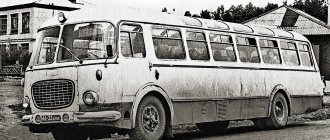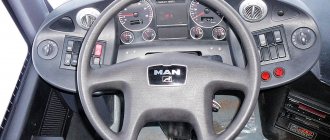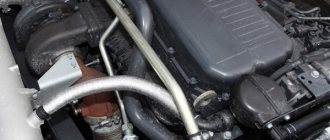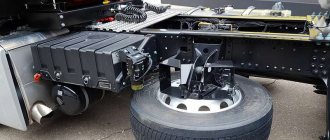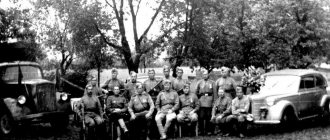Tire profile (height) for models of different years of manufacture.
Disclaimer: Although the data represents official manufacturer figures, the information above is for reference only and is not guaranteed to be absolutely accurate.
Since 1966, the plant has produced a 2.5-ton GAZ-52-03 car on a GAZ-51 chassis with a 75 hp engine. and a cabin from GAZ-53A. In 1975, it was replaced by the GAZ-52-04, which was a chassis with a cab from the GAZ-53A and the same 75-horsepower engine. It was offered in versions with an onboard platform and a chassis with a GAZ-52-01 and GAZ-52-02 cab with two wheelbase sizes (3300 and 3700 mm), like the SAZ-3503 dump truck, cargo-passenger taxis GAZ-52-05 and GAZ- 52-08, truck tractor GAZ-52-06. They were produced until the end of 1989.
SPECIFICATIONS
| 52-09 | ||
| Load capacity, kg | 2500 | 2500 |
| Curb weight, kg | 2685 | 2875 |
| Including: | ||
| to the front axle | 1305 | 1395 |
| to the rear axle | 1380 | 1480 |
| Total weight, kg | 5335 | 5525 |
| Including: | ||
| to the front axle | 1655 | 1755 |
| to the rear axle | 3680 | 3760 |
| Maximum speed, km/h | 70 | 70 |
| Control gas consumption at 60 km/h, l/100 km | 26 | 26 |
Engine
Modification GAZ-52-07 (basic GAZ-52-04, converted to run on LPG), power 54 kW (73 hp) at 2800 rpm, torque 196 Nm (20 kgfm) at 1600–1800 rpm.
Gas power system
The gas cylinder is mounted on the frame on the left side of the car. Maximum operating pressure 16 kgf/cm 2, useful volume 136 l, total volume - 151 l. The cylinder is equipped with a filling valve and two flow valves (steam and liquid phase), a fuel level indicator sensor, a filling device, safety and control valves. A two-stage gas reducer mol.-RZAA and a liquid gas evaporator are located in the engine compartment. Gas and gasoline fuel filters are equipped with RS-33601 solenoid valves to shut off the supply of gas and gasoline from the driver’s seat using the P-20A2 fuel type switch. Carburetor-mixer - K-126D, gas supply - through holes in diffusers. Gas pressure indicator - pressure gauge UK-1 30, located on the instrument panel. The MM-358 pressure sensor is located in the first stage of the gas reducer.
Car GAZ-52-27 4×2.2
Produced by the Gorky Automobile Plant on the basis of the GAZ-52-04 in 1984–1990. The main fuel is compressed natural gas (CNG), the backup fuel is A-76 gasoline.
SPECIFICATIONS
| Load capacity, kg | 2400 |
| Curb weight, kg | 2855 |
| Including: | |
| to the front axle | 1300 |
| to the rear axle | 1555 |
| Total weight, kg | 5405 |
| Including: | |
| to the front axle | 1640 |
| to the rear axle | 3765 |
| Maximum speed, km/h | 70 |
| Control gas consumption at 40 km/h, m 3 /100 km | 14,8 |
Engine
Modification GAZ-52-27 (basic GAZ-52-04, converted to run on LNG), compression ratio 7.0, power 48.5 kW (65 hp) at 2800 rpm, torque 182 N· m (18.6 kgf m) at 1600-1800 rpm.
GAZ-52 is one of the most produced medium-duty vehicles produced at the Gorky Automobile Plant (more than a million copies, excluding modifications). Despite the fact that the technical characteristics of the GAZ-52 demonstrate a hybrid version of the 51st and 53rd models, the car is interesting and unique in its own way.
History of production of GAZ-52
The time of the truck begins in 1958, when developed by A.D. Prosvirin (chief designer who also took part in the development of the 51st model) brought the experimental model to life for the first time. However, it was put into mass production only in 1966, after 8 years of testing and improvements. The cornerstone of the tests was the installation of a pre-chamber “engine”, which was equipped with the experimental models. The technical characteristics of such an engine were excellent for its time:
- 80 hp at 3 thousand rpm;
- volume 3485 cm3;
- compression ratio – 6.7;
- 2-chamber carburetor.
It was with this engine, running on A-66 gasoline, that in the year of its presentation the GAZ-52 received the Grand Prix in Brussels and was highly appreciated by foreign manufacturers. But as practice has shown, the operation of the engine turned out to be unstable, and adjusting the mixture supply was too complicated. That’s why we got the well-known version with a forced 75-horsepower engine from the GAZ-51. The onboard GAZ-52 did not immediately become popular, “massive”. Initially it was used only as a delivery van in the trade sector. But over time, when numerous modifications began to appear, the car became indispensable in agriculture, for public utilities, and even as a “cargo taxi.” In 1993, the production of new copies was completed due to the obsolescence and unprofitability of the model.
Car device
GAZ-52 is an all-wheel drive frame truck, the wealth of modifications of which is due to the possibility of using a vehicle with various mountings without significant design changes. All modifications of the 52nd model are divided into two types:
- short wheelbase (models 52-02 and 52-04 were used as dump truck chassis);
- long-wheelbase (flatbed versions, chassis for tanks or vans - “52A”, “52-01”, “52-03”).
GAZ-52 was created on the basis of the 51st and 53rd models, therefore it is somewhat similar to them (to a greater extent with the GAZ-53) in design and appearance. And this has a plus: the interchangeability of some parts (for example, springs, wheel rims will fit from the 53rd GAZ, the rear axle, the driveshaft from the GAZ-51A). As the owners note, in order to disassemble and reassemble the car, a standard set of tools is enough. The 2-seater, all-metal cabin is constructed according to the same ascetic principle. The “torpedo” contains sensors for fuel level, oil pressure, radiator fluid temperature, speedometer and ammeter. The seat is solid, more like a sofa, which is typical for Soviet GAZ passenger cars. By today's standards, there is little comfort, but at the time of release the GAZ-52 was not inferior to its ZIL counterparts.
Tire standards for GAZ 53
Tires for GAZ-53
Can you always trust the advice of auto repair shop employees? It’s not for nothing that they say: “Trust, but verify.” The owner of the car must understand which wheel is good and which tires are needed. If they are of poor quality, the vehicle will constantly “stumble.” Damage to the body and underbody parts is possible if you choose the wrong wheel size for the GAZ 53.
Electric cars, which are increasingly popular these days, for example, are necessarily protected by a spoiler, because the battery is attached to the bottom. If you choose the wrong tires, the risk of damage may increase.
It’s not for nothing that manufacturers recommend choosing only those that meet the technical parameters. This does not mean that it is not possible to “lift” the car or “land it”. The options that are available to the owner of a GAZ 53 will be discussed further.
Truck tires for GAZ 53 must be selected taking into account the following characteristics:
- disk size,
Dump truck GAZ 53 - maximum atmospheric pressure.
The GAZ 53 dump truck has a large load capacity and the weight of the vehicle itself. When buying truck tires on Avito or on the automobile market, you should definitely pay attention to these characteristics. The dump truck will soon crush cargo discs of the wrong size for large vehicles of a different type. And the point will not be their quality, but the fact that the load will be distributed unevenly.
Requires 20 inch tires. For a Chevrolet Cruze, for example, they buy wheels measuring 175/70 R13. And for GAZ 53 7.50 R20 or 8.25/R20. Accordingly, the last numbers and letter in the marking are the radius. Once upon a time, only diagonal wheels were made.
20 inch tires
If this vehicle is equipped with them, it will be marked as 8.25. Then more advanced radial ones were invented. They can be recognized by the numbers 7.50.
The first numbers indicate not only and not so much the type of wheels, but the width. In a Chevrolet Cruze it is 175 mm, in a GAZ 53 it is 7.5 inches. Truck tires are fitted with radial regular profile. It is close in shape to a circle.
On other cars there are wheels with a profile of a different type: they are wider, due to which the load capacity, stability, and wheel area increase, but their diameter does not change.
Technical characteristics of GAZ-52
Dimensions and weights:
- Length – 5.7 m (6.395 m – long wheelbase version).
- Width – 2.28 m (23.8 m for long wheelbase).
- The height without cargo in the cabin is 2.15 m (21.9 m).
- The turning radius is 7.5 m (along the outer side of the front wheels).
- The maximum lifting angle with a full load is 15°.
- The loading height of the onboard platform is 1.21 m (1.28 m).
- The weight of the GAZ-52 with a body is 5.17 tons; for long-wheelbase vehicles (for example, the GAZ-52 fuel truck) the weight is slightly higher - 5.465 tons.
- How much does the GAZ-52 weigh without a body - 2.52 tons (2.815 tons).
- What is the maximum weight of the trailer - 2.5 tons.
- What is the carrying capacity - 2.5 tons.
Power unit
After failures with the prechamber engine, it was decided to install the GAZ-52-01 engine on the 52nd model, which is a more powerful version of the engine of the 51st model. Motor characteristics:
- power – 75 “horses”;
- number of cylinders – 6, strokes – 4;
- engine type – carburetor, two-chamber;
- valve arrangement - in-line, bottom;
- volume – 3485 cm3;
- compression ratio number - 6.2;
- torque limit - 21 kgm in conditions of 1.6-1.8 thousand rpm;
- engine weight – 250 kg;
- cooling type – water.
The crankshaft, cylinder block, crankcase and its ventilation filter, and air filter were taken from a GAZ-53. Such a forced engine is quite “gluttonous” (especially if you take into account the not too large volume of the tank - 90 liters): fuel consumption per 100 km is 20-21 liters (subject to driving in 4th gear on a good road). Therefore, “gas” versions are more popular.
Brake system
Service brake parameters:
- by the number of circuits - 1-circuit;
- drive – hydraulic, with hydraulic-vacuum booster;
- type of mechanism on wheels - drum.
The parking brake is transmission, equipped with a mechanical drive.
Transmission
Main characteristics:
- clutch – 1-disc, dry;
- number of gears – 4;
- the presence of synchronizers in 3rd and 4th gear;
- final drive ratio – 6.67 (6.83 on base versions);
- disc diameter increased to 28 cm.
Most of the elements were “borrowed” from the GAZ-51A: main and intermediate cardan, intermediate cardan support, sliding fork. The 52nd version gearbox is considered relatively silent and wear-resistant.
Chassis
The frame of modifications with an extended base is the same as that of the 53rd car (wheelbase 3.7 m). The “short version” (wheelbase - 3.3 meters) is characterized by side members with reduced cross-sections. Frame weight – 197 (270) kg. “Innovations” affected the suspension: now the ends of the earless springs were embedded in rubber cushions, which reduced the load on the main sheets. The springs are equipped with 0.5-elliptical, longitudinal, rear suspension is devoid of shock absorbers, but has an additional spring.
The truck is easy to drive, but the steering mechanism (globoid with 2 lug rollers) takes some getting used to as there is no power assist. The spare parts catalog (especially considering interchangeability) is easily accessible, so in case of repairs you can get everything and do it yourself.
The lineup
Over the almost 40-year history of production, the GAZ-52 has acquired a huge number of modifications, among which a large number are experienced models that have not gone to the masses:
- GAZ-52F (failed experiment with a prechamber 85-horsepower engine with a load capacity of 2.5 tons);
- GAZ-52G (did not become mass-produced due to operational restrictions - the presence of only hard surfaces);
- GAZ-52A (base for special vans);
- GAZ-52P (tractor, experimental short wheelbase);
- GAZ-52Ya (variation with a short body).
However, the number of production models far exceeds the number of experimental ones:
- GAZ-52-01 (long-wheelbase version, used as a chassis for special equipment with a load limit of 2.5 tons);
- 52-02nd model (short wheelbase chassis for SAZ-3503, -3504 dump trucks);
- 52-03rd model (a classic flatbed truck with an extended wheelbase, it was replaced already in the 70s by the GAZ-52-04, the photo of which confirms the similarity);
- 52-04th model (flatbed modification with a shortened wheelbase, maximum load - 2.5 tons);
- GAZ-52-05 (a cargo taxi with a tilt-raised platform, structurally almost no different from the “52-04”);
- “52-06” (tractor, trailer weight limit – 6 tons);
- “52-07” (powered by liquefied gas, the cylinder is attached to the frame on the left);
- 52-09th model (modification of the 52-02nd model, “powered” by liquefied gas);
- “52-08” (compressed natural gas (CNG) is used for operation, duplicating A-76 gasoline);
- 52-27th version (base – “52-04”, powered by LNG);
- GAZ-52-28 (engine from “52-27”, but the cylinders are placed not on the frame, but behind the body).
Two export models were produced separately:
- 52-54 (area of operation – with a tropical climate);
- 52-74 (operating conditions – moderate climate).
In addition, a mobile repair workshop (MPR-99-24) and a ladder truck (AL-18) were produced on the 52-01 version chassis.
GAZ-52 is a real legend that still continues to ply Russian roads. In any case, the secondary market at a price of 40 thousand rubles offers a lot of options. And they have a chance to find a review for several reasons: the simplicity of the design, the simplicity and ability to save money on repairs and, of course, sufficient potential to perform the tasks that agriculture and municipal services pose for the truck.
The Gorky Automobile Plant was built in 1932 with the assistance of the American Ford Motor Company. The establishment of mass production began with the production of one and a half ton trucks and the 5-seater GAZ-A with a phaeton-type body. By 1981, the 10 millionth car had already rolled off the assembly line, and the 21st Volgas produced in the 60s, which have long become a rarity, can occasionally be seen on the roads to this day. What does the plant produce today, what tires and wheels can be installed on the Gazelle and other cars of this manufacturer? Read about this in our article.
A short excursion into history
In the post-war years, the Gorky plant replaced the model range that had been developed before the war - including the famous Pobeda, which was included in the series in 1946, which was replaced in 1956 by the GAZ 21 Volga. In 1950, the world saw the large executive sedan ZIM (9 years later it was replaced by the Chaika GAZ 13), and the first jeep, called GAZ 69, was released.
You can't even tell that this car is 63 years old.
GAZ-69 - the ancestor of the UAZ
GAZ-66 turned out to be not so easy to replace
Note: Volga, Chaika and GAZ-52 truck received the highest Grand Prix award at an exhibition in Brussels in 1958.
Next, we began to develop a new family of passenger cars, not only with front-wheel drive, but also with all-wheel drive. Among them was the executive sedan GAZ 3105 and options for mass production, the front-wheel drive GAZ-3103 and all-wheel drive GAZ-3104. True, due to the crisis of the 90s, they never went into series.
GAZika's birthdayRetro test of GAZ-51 to commemorate the 60th anniversary of the model
S. Iones, photo by the author
60 years ago, in June 1946, the Gorky Automobile Plant produced the first batch of production GAZ-51 trucks. Its predecessor, the GAZ-MM, was a light-duty vehicle in which not only the engine, but also the hood and wings were from a passenger car. GAZ-51 has become an “adult” truck. In terms of power and carrying capacity, it was close to the ZIS-5. Over the 29 years of production, a lot has changed in this car, and the GAZ-51 of the early 1970s was significantly different from the one assembled in the 1940s.
Finding an onboard GAZ-51 in good condition in Moscow was not difficult. The GAZ car shown in the photographs is one of the last - produced in 1974. By that time, the plant had already been producing next-generation trucks for 10 years - GAZ-52 and GAZ-53, and on the GAZ passenger conveyor line "21st" Volga had long given way to "24th". This GAZ-51 is younger than the first million Zhigulis!
The well-preserved nameplate shows the GAZ-51S modification index. This means that the car has two gas tanks, like the off-road GAZ-63. This version of the “51st” was intended for transport enterprises engaged in intercity transportation. In addition to the “standard” 90-liter tank under the cab, a large mileage without refueling is provided by an additional 105-liter tank on the left under the platform. The necks are located nearby, and refueling is very convenient. We drive up to the pump on the left side of the car and, when one tank is full, transfer the gun to the second. This is not a UAZ, in which the neck of one tank is on the right, and the second on the left.
As you know, over the years of production, the GAZ-51 has had three generations of cabs: first, a wooden one without side mudguards, then a metal one with wooden doors and removable corrugated mudguards, and, finally, an all-metal one with smooth welded mudguards. The cockpit with tail bore its own GAZ-81 designation. When the plant mastered the all-metal cabin, they tried to use side windows without windows, like the ZIS-150. Interesting fact: in the 1970s, a small number of GAZ cabs were painted not green, beige and gray, but bright orange.
At first glance, the cabin seems cramped. But there is enough space for the driver and one passenger. Only when engaging reverse gear does the huge lever bump into the passenger's left foot. GAZ has very soft seats, similar to those in old subway cars. The seat is not adjustable, but paradoxically the driving position seems comfortable for both short and tall people!
At least three different steering wheels were used on the GAZ-51; even the steering column was slightly shortened in 1950. Drivers sometimes installed the GAZ-21 steering wheel themselves. In 1957, the outboard starter pedal was replaced with a rod pedal from Pobeda. The old starter switch was closer to the gas pedal than the new one. Old Gorky cars, in addition to the choke, have a manual throttle control handle. It helps you move in reverse.
Until 1950, the heater and windshield defogger were installed only on the GAZ-63 and the northern version of the GAZ-51. Later they began to equip all cars. In the late 1950s, a wiper blade appeared on the right half of the window. The first 51s had a beautiful instrument cluster model KP-5. In 1951, the GAZ-51 was equipped with round devices from the ZIS-150, similar to those used on today's UAZs and some trucks. The glove box lock with the Pobeda button was replaced in the 1960s with a plastic handle with a latch. Note that on the UAZ “loaf” the old lock with a button survived into the 21st century.
Regardless of the cab, the GAZ car retained its usual appearance: the wings, hood, and trim did not change. Long before the invention of the term “corporate style,” design solutions in the spirit of the GAZ-51 were used on various Soviet cars. The 51st first had a “younger brother” GAZ-69, then a “big brother” Ural-355M. In the 1950s, the PAZ-651 bus had an original hood and lining made in the same style. Later, the bus received a hood unified with the GAZ-51.
Oil flask
The sides of the hood of the GAZ-51 and its “relatives” are easily removed. In summer they are removed so that the engine heats up less. The hood is locked from the outside with characteristic hooks, and there is no protection against thieves. The raised lid is held in place by the same stop as in the trunk of the Pobeda and ZIM. When you open the hood, you notice that the inline 6-cylinder lower valve engine is “recessed” deeply, like on cars of the 1930s. Removable sides make the low-mounted motor easy to access for maintenance.
The GAZIK engine received modern liners instead of Babbitt “fills”. In the 1940s, it seemed powerful: it developed 70 hp, and the in-line “six” ZIS-5 of a much larger displacement produced 73 hp. The low compression ratio of the base model softened the requirements for the octane number of gasoline. Modifications to an engine similar to the GAZ-51 were boosted to 80...90 hp, increasing the compression ratio and increasing the flow area of the manifolds. The maximum torque at 1500 rpm not only provided excellent traction, but also made it possible to easily start the engine with the starting handle if the battery was old or the starter was faulty. The cylinder block could withstand up to five repair borings.
The old engines continued to run poorly with low oil pressure and poor compression, and repairing them was not difficult. To change the liners, you do not need to remove the engine from the mounts: the front axle does not interfere with removing the pan. The oil pump can be removed and repaired without disassembling the engine: it is housed in a separate housing on the right side of the block under the manifold. The lower valve head can be removed quite easily. Ignition adjustment is simplified by the fact that the distributor and the top dead center control window on the flywheel housing are located on one left side.
True, for basic valve adjustment it is necessary to remove the intake and exhaust manifolds, which means disconnecting the carburetor and unscrewing a lot of fasteners. It’s good that valve clearances can be set relatively rarely on a lower-valve engine.
Over the years, the plant installed several models of carburetors, ignition coils, generators, and relay regulators on the GAZ-51. The radiator was replaced four times. At first, the pump and generator were driven by two belts, like the GAZ-24. In September 1955, one stronger belt was installed, but for another six months two streams remained on the pulleys.
On “our” car, the small canister included in the factory configuration for storing a supply of engine oil survived. It was installed on the right rear wheel mudguard.
The GAZ-51 does not have power steering or brakes, but the effort on the steering wheel and pedals feels no more than on a Volga, at least on an empty truck. The dimensions also feel good: the size of the Gazik is comparable to other modern pickup trucks. Driving the 51 would be easy if not for the gearbox.
The lack of synchronizers in the gearbox requires you to squeeze the clutch twice. It's not difficult to get used to, but at first you can't change gear without grinding. Modern cars and the intensity of current traffic have taught us to change gears with a quick movement of the hand. The lever of the old Gorky truck must be moved much more slowly: in its box gears of large sizes and weights with spur gears rotate, and in the crankcase there is an archaic nigrol lubricant. GAZ-51 is designed for leisurely driving, allowing for slow gear changes.
The “ancient” GAZ cars did not have direction indicators or a right rear light. In 1956, a turn signal section was added to the sidelights and taillights, and a power switch appeared in the middle of the dashboard. The small round outside mirror was only installed on the left side, even on trucks with curtains and vans. The owner equipped “our” car with a second mirror of the same type on the right and added a passenger interior mirror from Moskvich-401.
Previously, the truck only relied on front shock absorbers. In 1964, following the Volga, the GAZ-51 received telescopic shock absorbers instead of lever ones. The factory changed spring parts many times. At least three times - rims. GAZ-51 wheels are interchangeable with many cars from AMO-2 to GAZ-3309.
In the 1950s, the GAZ-51 lost such a useful device as a tire inflation compressor driven by the intermediate shaft of the gearbox. At the same time, the plant abandoned the semi-centrifugal clutch and disc transmission brake. And the intermediate support, according to the drivers, remained unreliable, a little better than that of the GAZelle.
The onboard platform, used since 1956 on the base GAZ-51A, differed from the platform of previous releases not only in three folding sides. It was made a little wider, which made it possible to lay logs 2 m long across the body. On the front side of “our” car there is a folding bench. In the 21st century in Russia, passengers are rarely carried in the open back of a flatbed truck. During the “51s,” half the country traveled this way, including in winter. There was nothing to protect passengers from the headwind. There are no steps to enter the body. You need to put your foot on the rear wheel, grab the side with both hands, rise and climb over it. When exiting, holding onto the side, we move our feet onto the wheel and jump off. If the height of the sides is not increased, even a short and untrained person can easily do this.
A decade and a half after the GAZ-51 was discontinued, the plant produced the GAZ-5204 truck, which retained many of the features of its predecessor. Most GAZ-51s disappeared from Moscow car depots as a result of a demonstrative update of freight transport for the 1980 Olympics. In the provinces and in small motor vehicles in large cities, many cars survived until perestroika, when it became possible to privatize trucks. Private owners and co-operators also did not always take care of old vehicles; they without pity exchanged GAZ cars for economical GAZelles and used foreign cars. Nowadays it has become fashionable to restore vintage cars, but surviving GAZ-51s still “kill” autocross masters at races. The truck that we see in the photographs was restored not in a restoration studio, but by the mechanics of an ordinary Moscow car depot. At least one early GAZ-51 from the 1940s has survived to this day in the Latvian automobile museum Uzvara.
The editors thank Egor Karpunin and Vladimir Berberov for their assistance in preparing the material.


